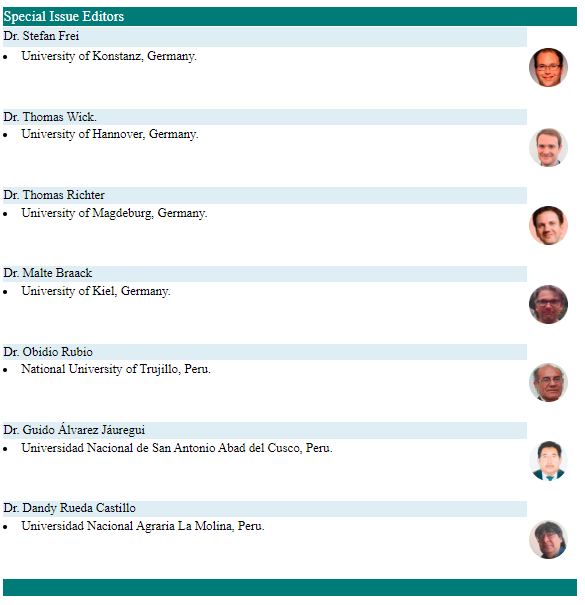Prey refuge use: its impact on the dynamics of the Lotka-Volterra model
DOI:
https://doi.org/10.17268/sel.mat.2022.02.06Keywords:
Predator-prey model, refuge, stability, bifurcations, limit cycles, separatrix curvesAbstract
In several previous works, different predation models have been modified by considering the use of prey refuges, for which a partial analysis of their dynamics is done.
In some of them, it is stated that the use of refuge has a stabilizing effect on the predator-prey interaction. One of the purposes of this paper is to show that some of these new systems, derived from the Lotka-Volterra model, this assertion is not fulfilled.
In this work, several of the models studied have more than one positive equilibrium point, and the behavior of the solutions is highly dependent on the initial conditions
References
Almanza-Vásquez E. Dinámicas de modelos de depredación, considerado una función con saturación para el uso de refugio por parte de las presas, Tesis Maestría en Biomatemáticas, Facultad de Ciencias Básicas y Tecnologías, Universidad del Quindío, Armenia, Colombia 2007.
Almanza-Vásquez E, González-Olivares E, González-Yañez B. Dynamics of Lotka-Volterra model considering satured refuge for prey, In R. Mondaini (Ed.) BIOMAT 2011 International Symposium on Mathematical and Computational Biology, World Scientific Co. Pte. Ltd. 2012; 62-72.
Bazykin AD. Nonlinear Dynamics of interacting populations, World Scientific Publishing Co. Pte. Ltd., Singapore, 1998.
Berryman AA, Gutierrez AP, Arditi R. Credible, parsimonious and useful predator-prey models - A reply to Abrams, Gleeson, and Sarnelle, Ecology. 1995; 76(6):1980-1985.
Chen F, Chen L, Xie X. On a Leslie Gower predator prey model incorporating a prey refuge, Nonlinear Analysis: Real World Applications. 2009; 10:2905-2908.
Chen L, Chen F, Chen L Qualitative analysis of a predator-prey model with Holling type II functional response incorporating a constant prey refuge. Nonlinear Anal Real World Appl. 2010; 11(1):246-252.
Clark CW. Mathematical Bioeconomic. The optimal management of renewable resources, John Wiley and Sons, 1990.
Epstein JM. Nonlinear Dynamics, Mathematical Biology, and Social Sciences. Addison-Wesley Publishing Company, 1997.
Freedman HI. Deterministic Mathematical Model in Population Ecology. Marcel Dekker, 1980.
Gause GF. The Struggle for Existence, The Williams & Wilkins company, Baltimore, 1934.
Goh B-S. Management and Analysis of Biological Populations. Elsevier Scientific Publishing Company, 1980.
González-Olivares E, Ramos-Jiliberto R. Dynamic consequences of prey refuges in a simple model system: more prey, fewer predators and enhanced stability, Ecological Modelling, 2003; 166:135-146.
González-Olivares E, Ramos-Jiliberto R. Consequences of prey refuge use on the dynamics of some simple predator-prey models: Enhancing stability?, In R. Mondaini (ed.), Proceedings of the Third Brazilian Symposium on Mathematical and Computational Biology (BIOMAT-2003), E-Papers Serviços Editoriais Ltda., Rio de Janeiro, 2004; V. 2:75-98.
González-Olivares E, Huincahue-Arcos J. A two-patch model for the optimal management of a fishing resource considering a marine protected area, Nonlinear Analysis: Real World and Applications. 2011; 12:2489-2499.
González-Olivares E, Ramos-Jiliberto R. Comments to "The effect of prey refuge in a simple predator-prey model" [Ecol. Model. 222 (September(18)) (2011) 3453-3454], Ecological Modelling. 2012; 232:158-160.
González-Olivares E, González-Yañez B, Becerra-Klix R. Prey refuge use as a function of predator-prey encounters, Private communication, submitted (2012).
González-Olivares E, González-Yañez B, Becerra-Klix R, Ramos-Jiliberto R. Multiple stable states in a model based on predator-induced defenses, Ecological Complexity. 2017; 32:111-120.
Haque M, Sabiar Rahman M, Venturino E, Li B-L. Effect of a functional response-dependent prey refuge in a predator-prey model, Ecological Complexity. 2014; 20:248-256.
Harrison GW. Global stability of predator-prey interactions, Journal of Mathematical Biology. 1979; 8:139-171.
Ma Z, Li W, Zhao Y, Wang W, Zhang H, Li Z. Effects of prey refuges on a predator-prey model with a class of functional responses: the role of refuges, Mathematical Biosciences. 2009; 218(2):73-79.
Ma Z, Li W, Wang S. The effect of prey refuge in a simple predator-prey model, Ecological Modelling. 2011; 222:3453-3454.
May RM. Stability and complexity in model ecosystems. 2nd edition: Princeton University Press, 2001.
Maynard Smith J. Models in Ecology. CambridgeUniversity Press, 1974.
McNair JM. The effects of refuges on predator-prey interactions: a reconsideration, Theoretical Populations Biology. 1986; 29:38-63.
Molla H, Sabiar Rahman M, Sarwardi S. Dynamics of a predator-prey model with Holling type II functional response Incorporating a prey refuge depending on both the species, International Journal of Nonlinear Sciences and Numerical Simulation. 2019; 20(1):89-104.
Ramos-Jiliberto R, González-Olivares E. Relating behavior to population dynamics: a predator-prey metaphysiological model emphasizing zooplankton diel vertical migration as an inducible response, Ecological Modelling. 2000; 127:221-233.
Ruxton GD. Short term refuge use and stability of predator-prey models, Theoretical Population Biology. 1995; 47:1-17.
Sih A. Prey refuges and predator-prey stability, Theoretical Populations Biology. 1987; 31:1-12.
Taylor RJ. Predation. Chapman and Hall, 1984.
Turchin P. Complex population dynamics. A theoretical/empirical synthesis. Mongraphs in Population Biology 35 Princeton University Press, 2003.
Volterra V. Variazioni e fluttuazioni del numero de individui in specie animali conviventi. Memorie della R. Accademia dei Lincei, S.VI, IT. 1926; 2:31-113.
Downloads
Published
How to Cite
Issue
Section
License
Copyright (c) 2022 Selecciones Matemáticas

This work is licensed under a Creative Commons Attribution 4.0 International License.
The authors who publish in this journal accept the following conditions:
1. The authors retain the copyright and assign to the journal the right of the first publication, with the work registered with the Creative Commons Attribution License,Atribución 4.0 Internacional (CC BY 4.0) which allows third parties to use what is published whenever they mention the authorship of the work And to the first publication in this magazine.
2. Authors may make other independent and additional contractual arrangements for non-exclusive distribution of the version of the article published in this journal (eg, include it in an institutional repository or publish it in a book) provided they clearly state that The paper was first published in this journal.
3. Authors are encouraged to publish their work on the Internet (for example, on institutional or personal pages) before and during the review and publication process, as it can lead to productive exchanges and to a greater and more rapid dissemination Of the published work.












